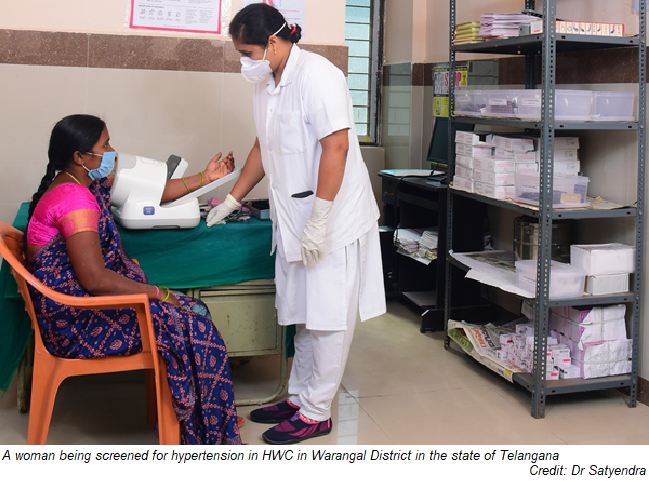Increasing longevity, unhealthy diets and sedentary lifestyles have led to an increase in non-communicable disease (NCDs) such as heart disease, diabetes and cancers in India, which now account for 64% of the disease burden in the country.
To combat diabetes, hypertension and the three most common cancers – oral, breast and cervical cancers -- the Government of India has launched “Population-based screening (PBS) of common NCDs” at the community and primary health care level.
PBS provides promotive, preventive, curative and referral services as part of comprehensive primary health care at Health and Wellness Centres (HWCs) across the country. It provides equitable access for NCDs screening and management at the community level by utilizing the services of the health care workers and frontline workers under the existing primary healthcare system.
Prime Minister Narendra Modi reiterated the government’s commitment to lowering the NCDs burden in the country by launching the PBS portal that tracks the health status of registered people with a high risk of NCDs in Jangla block in the aspiration district of Bijapur in Chhattisgarh. PBS services primarily focus on populations in aspiration districts with poor socio-economic indicators to ensure services reach the most marginalized and vulnerable populations.

NCDs threaten progress towards meeting the Sustainable Development Goals, which includes a target of reducing premature deaths from NCDs by one-third by 2030. The rapid rise in NCDs threatens poverty reduction initiatives by increasing morbidity and household expenditure on health care.
WHO Country Office has been an integral part of the PBS initiative since its inception and roll out, and further support is being provided for its convergence with HWCs.
Intensive trainings have been held to provide quality services, including screening of communities against diabetes, hypertension, oral cancers, and the two most common cancers among women (breast and cervical cancer), for early detection and management.
PBS has potential to reach 500 million adults by 2022. It also prioritizes screening and referral services to individuals who have a higher risk of developing NCDs – such as users of smokeless tobacco that raises the risk of oral cancers -- through risk assessment scores.
Till March 2021, more than 25 000 medical officers, 24 000 staff nurses, 100 000 female multipurpose workers, and 400 000 ASHAs have been trained to provide screening and referral services. In the same period, PBS has covered 64 million individuals above the age of 30 years, and close to 4.3 million women have been referred for cervical cancer screening based on the risk assessment at the primary health care level.
“We have started NCD screening of the target population on five common NCDs (hypertension, diabetes, and oral, breast and cervical cancers) but the screening for cervical cancer is mainly done at the link-Primary Health Centre (PHC). After the screening we list out the suspect cases and refer them to link PHC for confirmation. If confirmed, strict follow-up is done by the SC-HWC team members. While providing all these services, we never discriminate beneficiaries in the line of caste, creed, religion, rich, wealth etc.,” said Mr Rituparna Hazarika, Community Health Officer at Manipurtup Sub Centre-HWC, in the Raha Tehsil of Nagaon district in the state of Assam.
PBS data are disaggregated by age, gender and place of residence, as well as ethnicity and other socio–economic indicators, which will be used by district-level and grassroots managers to improve inequalities in access to care.
